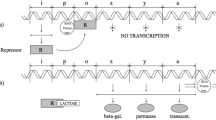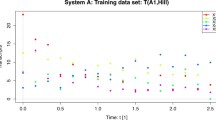Abstract
A set of genes and their regulatory interactions are represented in a gene regulatory network (GRN). Since GRNs play a major role in maintaining the cellular activities, inferring these networks is significant for understanding biological processes. Among the models available for GRN reconstruction, our recently developed nonlinear model [1] using Michaelis-Menten kinetics is considered to be more biologically relevant. However, the model remains coupled in the current form making the process computationally expensive, especially for large GRNs. In this paper, we enhance the existing model leading to a decoupled form which not only speeds up the computation, but also makes the model more realistic by representing the strength of each regulatory arc by a distinct Michaelis-Menten constant. The parameter estimation is carried out using differential evolution algorithm. The model is validated by inferring two synthetic networks. Results show that while the accuracy of reconstruction is similar to the coupled model, they are achieved at a faster speed.
Access this chapter
Tax calculation will be finalised at checkout
Purchases are for personal use only
Similar content being viewed by others
References
Youseph, A.S.K., Chetty, M., Karmakar, G.: Gene regulatory network inference using Michaelis-Menten kinetics. In: IEEE Congress on Evolutionary Computation (CEC), pp. 2392?2397 (2015)
Kauffman, S.A.: Metabolic stability and epigenesis in randomly constructed genetic nets. J. Theor. Biol. 22(3), 437?467 (1969)
Akutsu, T., Miyano, S., Kuhara, S.: Identification of genetic networks from a small number of gene expression patterns under the boolean network model. In: Pacific Symposium on Biocomputing, vol. 4, pp. 17?28 (1999)
Ram, R., Chetty, M.: A markov-blanket-based model for gene regulatory network inference. IEEE/ACM Trans. Comput. Biol. Bioinform. 8(2), 353?367 (2011)
Xuan, N., Chetty, M., Coppel, R., Wangikar, P.: Gene regulatory network modeling via global optimization of high-order dynamic Bayesian network. BMC Bioinform. 13(1), 131 (2012)
Kabir, M., Noman, N., Iba, H.: Reverse engineering gene regulatory network from microarray data using linear time-variant model. BMC Bioinform. 11(Suppl. 1), S56 (2010)
Wu, F.X., Liu, L.Z., Xia, Z.H.: Identification of gene regulatory networks from time course gene expression data. In: Annual International Conference of the IEEE Engineering in Medicine and Biology Society (EMBC), pp. 795?798 (2010)
Hirose, O., Yoshida, R., Imoto, S., Yamaguchi, R., Higuchi, T., Charnock-Jones, D.S., Print, C., Miyano, S.: Statistical inference of transcriptional module-based gene networks from time course gene expression profiles by using state space models. Bioinformatics 24(7), 932?942 (2008)
Tamada, Y., Yamaguchi, R., Imoto, S., Hirose, O., Yoshida, R., Nagasaki, M., Miyano, S.: Sign-ssm: open source parallel software for estimating gene networks with state space models. Bioinformatics 27(8), 1172?1173 (2011)
Maki, Y., Ueda, T., Okamoto, M., Uematsu, N., Inamura, K., Uchida, K., Takahashi, Y., Eguchi, Y.: Inference of genetic network using the expression profile time course data of mouse p19 cells. Genome Inf. 13, 382?383 (2002)
Chowdhury, A., Chetty, M.: An improved method to infer gene regulatory network using S-system. In: IEEE Congress on Evolutionary Computation (CEC), pp. 1012?1019 (2011)
Chowdhury, A., Chetty, M., Vinh, N.X.: Adaptive regulatory genes cardinality for reconstructing genetic networks. In: IEEE Congress on Evolutionary Computation (CEC), pp. 1?8 (2012)
Storn, R., Price, K.: Differential evolution - a simple and efficient adaptive scheme for global optimization over continuous spaces. Technical report. TR-95-012, ICSI, March 1995. http://www1.icsi.berkeley.edu/~storn/litera.html
Cantone, I., Marucci, L., Iorio, F., Ricci, M.A., Belcastro, V., Bansal, M., Santini, S., di Bernardo, M., di Bernardo, D., Cosma, M.P.: A yeast synthetic network for in vivo assessment of reverse-engineering and modeling approaches. Cell 137(1), 172?181 (2009)
Chowdhury, A., Chetty, M., Vinh, N.: Incorporating time-delays in S-system model for reverse engineering genetic networks. BMC Bioinform. 14(1), 196 (2013)
Zoppoli, P., Morganella, S., Ceccarelli, M.: Timedelay-aracne: reverse engineering of gene networks from time-course data by an information theoretic approach. BMC Bioinform. 11(1), 154 (2010)
Yu, J., Smith, V.A., Wang, P.P., Hartemink, A.J., Jarvis, E.D.: Advances to Bayesian network inference for generating causal networks from observational biological data. Bioinformatics 20(18), 3594?3603 (2004)
Noman, N., Iba, H.: Inferring gene regulatory networks using differential evolution with local search heuristics. IEEE/ACM Trans. Comput. Biol. Bioinf. 4(4), 634?647 (2007)
Acknowledgments
This work was partly supported by Australian Federal and Victoria State Governments and the Australian Research Council through the ICT Centre of Excellence program, National ICT Australia (NICTA).
Author information
Authors and Affiliations
Corresponding author
Editor information
Editors and Affiliations
Rights and permissions
Copyright information
© 2015 Springer International Publishing Switzerland
About this paper
Cite this paper
Youseph, A.S.K., Chetty, M., Karmakar, G. (2015). Decoupled Modeling of Gene Regulatory Networks Using Michaelis-Menten Kinetics. In: Arik, S., Huang, T., Lai, W., Liu, Q. (eds) Neural Information Processing. ICONIP 2015. Lecture Notes in Computer Science(), vol 9491. Springer, Cham. https://doi.org/10.1007/978-3-319-26555-1_56
Download citation
DOI: https://doi.org/10.1007/978-3-319-26555-1_56
Published:
Publisher Name: Springer, Cham
Print ISBN: 978-3-319-26554-4
Online ISBN: 978-3-319-26555-1
eBook Packages: Computer ScienceComputer Science (R0)





